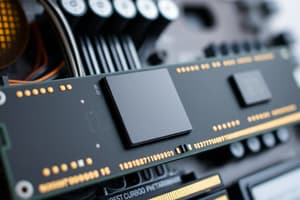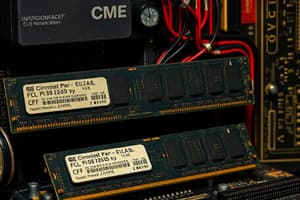Podcast
Questions and Answers
What is the full form of CPU?
What is the full form of CPU?
- Central Performance Unit
- Central Power Unit
- Central Processing Unit (correct)
- Central Programmable Unit
What is the function of the Arithmetic Logic Unit (ALU) in a CPU?
What is the function of the Arithmetic Logic Unit (ALU) in a CPU?
- To store temporary data
- To perform arithmetic and logical operations (correct)
- To control the flow of instructions
- To extract and decode instructions
What is the unit of measurement for CPU clock speed?
What is the unit of measurement for CPU clock speed?
- Kilohertz (kHz)
- Megahertz (MHz)
- Hertz (Hz) (correct)
- Gigahertz (GHz)
What type of memory is RAM?
What type of memory is RAM?
What is the capacity of RAM rated in?
What is the capacity of RAM rated in?
What is the function of the Control Unit (CU) in a CPU?
What is the function of the Control Unit (CU) in a CPU?
What type of memory is ROM?
What type of memory is ROM?
What is the time it takes to read or write to RAM measured in?
What is the time it takes to read or write to RAM measured in?
What is the function of a scanner?
What is the function of a scanner?
What is the purpose of a microphone?
What is the purpose of a microphone?
What is a joystick also known as?
What is a joystick also known as?
What is the function of a trackball?
What is the function of a trackball?
What is a barcode reader also known as?
What is a barcode reader also known as?
What is the main function of a webcam?
What is the main function of a webcam?
What component holds the CPU, RAM, ROM, and other components?
What component holds the CPU, RAM, ROM, and other components?
What is an electronic pen also known as?
What is an electronic pen also known as?
What is the maximum storage capacity of a hard disk for personal computers?
What is the maximum storage capacity of a hard disk for personal computers?
What is the purpose of partitioning a hard disk into different drives?
What is the purpose of partitioning a hard disk into different drives?
What is the capacity of a CD-ROM?
What is the capacity of a CD-ROM?
What is the full form of DVD?
What is the full form of DVD?
What is the minimum memory capacity of a flash disk?
What is the minimum memory capacity of a flash disk?
What is another name for a flash disk?
What is another name for a flash disk?
What is the maximum storage capacity of a flash disk?
What is the maximum storage capacity of a flash disk?
What are SD cards used for?
What are SD cards used for?
Which device is an example of an output device?
Which device is an example of an output device?
What is the function of the CPU?
What is the function of the CPU?
What is a PS/2?
What is a PS/2?
What type of device is a hard disk?
What type of device is a hard disk?
What is softcopy?
What is softcopy?
What is a common term for a Visual Display Unit (VDU)?
What is a common term for a Visual Display Unit (VDU)?
What is the unit of measurement for CPU clock speed?
What is the unit of measurement for CPU clock speed?
What are the two primary memory types in a computer?
What are the two primary memory types in a computer?
What is the full form of ROM?
What is the full form of ROM?
What type of output does a printer produce?
What type of output does a printer produce?
What is the full form of VDU?
What is the full form of VDU?
What is the most used type of printer?
What is the most used type of printer?
What is the storage capacity of a CD ROM?
What is the storage capacity of a CD ROM?
What is Flash memory also known as?
What is Flash memory also known as?
Flashcards
CPU (Central Processing Unit)
CPU (Central Processing Unit)
The brain of the computer responsible for executing instructions.
Microprocessor
Microprocessor
A single chip that houses the CPU.
Control Unit (CU)
Control Unit (CU)
Part of the CPU that extracts, decodes, and executes instructions.
Arithmetic Logic Unit (ALU)
Arithmetic Logic Unit (ALU)
Signup and view all the flashcards
Registers
Registers
Signup and view all the flashcards
Hertz (Hz)
Hertz (Hz)
Signup and view all the flashcards
RAM (Random Access Memory)
RAM (Random Access Memory)
Signup and view all the flashcards
Volatile memory
Volatile memory
Signup and view all the flashcards
ROM (Read Only Memory)
ROM (Read Only Memory)
Signup and view all the flashcards
Scanner
Scanner
Signup and view all the flashcards
Touch Screen
Touch Screen
Signup and view all the flashcards
Microphone
Microphone
Signup and view all the flashcards
Joystick
Joystick
Signup and view all the flashcards
Trackball
Trackball
Signup and view all the flashcards
Barcode Reader
Barcode Reader
Signup and view all the flashcards
Webcam
Webcam
Signup and view all the flashcards
Motherboard
Motherboard
Signup and view all the flashcards
Hard Disk
Hard Disk
Signup and view all the flashcards
Compact Disk (CD)
Compact Disk (CD)
Signup and view all the flashcards
Digital Versatile Disk (DVD)
Digital Versatile Disk (DVD)
Signup and view all the flashcards
Flash Disk
Flash Disk
Signup and view all the flashcards
Secure Digital (SD) Card
Secure Digital (SD) Card
Signup and view all the flashcards
Monitor
Monitor
Signup and view all the flashcards
Printer
Printer
Signup and view all the flashcards
USB Port
USB Port
Signup and view all the flashcards
Audio Port
Audio Port
Signup and view all the flashcards
Parallel Port
Parallel Port
Signup and view all the flashcards
VGA Port
VGA Port
Signup and view all the flashcards
Study Notes
CPU (Central Processing Unit)
- CPU full form is a Central Processing Unit.
- It is housed in a single chip called a microprocessor.
- It is also known as the brain of the computer.
- It runs the instructions of a computer program by performing arithmetic and logical operations.
- CPU clock speed is measured in units of cycles per second, which is called a Hertz (Hz).
- CPUs run at rates of millions and billions of Hertz, Mega Hertz (MHz), and generally in Giga Hertz (GHz).
- The main parts of a Processor are:
- Control Unit (CU), which extracts, decodes, and executes instructions from memory.
- Arithmetic Logic Unit (ALU), which performs all arithmetic computations and comparison operations.
- Registers (Temporary storage space)
Memory
- Two types of primary storage are located in the computer namely RAM and ROM.
- RAM – Random Access Memory:
- It is also known as Read-Write memory and main memory (Temporary memory).
- RAM is a volatile memory.
- Any information stored in RAM is lost when the computer is turned off.
- The time it takes to read or write to it is measured in nanoseconds.
- The capacity of the RAM is one of the factors that determine the power of the computer.
- Its capacity is rated in megabytes.
- ROM – Read Only Memory:
- ROM has programs that are inbuilt at the factory.
- The information in this memory cannot be written on or erased by the computer user.
Input Devices
- Scanner: an input device that captures images from photographic prints, posters, magazine pages, and similar sources for computer editing and display.
- Touch Screen: the assembly of both an input ('touch panel') and output ('display') device.
- Microphone: an input device used in computers for recording voice and speech recognition.
- Joy Stick: an input device also called a game controller used with video games or entertainment systems to provide input for the video game.
- Electronic Pen or a digital Pen or a stylus: a small pen-shaped instrument whose tip position on a computer monitor can be detected.
- Trackball: a pointing input device consisting of a ball held by a socket containing sensors to detect a rotation of the ball.
- Barcode Reader: a hand-held or stationary input device used to capture and read the information contained in a barcode.
- Webcam: a digital video device commonly built into a computer.
Motherboard
- The motherboard is the main circuit board of a microcomputer that connects all system components to each other.
- It holds the CPU, RAM, ROM, and other components.
Storage Devices
- Hard Disks: range from 500GB to 2TB (Terabytes) or even more.
- Compact Disks (CDs):
- Also known as an optical disk and is circular in shape.
- A CD-ROM (read-only memory) is a compact disc that used the same laser technology as audio CDs for recording music.
- The capacity of a CD-ROM is 700 MB of data.
- CDs are used for storing music and large graphic files.
- Three types of CDs: CD-ROM (Compact Disk – Read Only Memory), CD-R (Compact Disk – Recordable), and CD-RW (Compact Disk – Rewritable).
- Digital Versatile Disk (DVD):
- Holds a much larger amount of information (such as movies).
- Holds 4.7 GB (Gigabytes) of data.
- Different types of DVDs: DVD-Video, DVD-ROM, DVD+R, DVD+RW, DVD-RAM, and HD-DVD.
- Flash Disk:
- Also known as a USB drive (Universal Serial Bus) or Pen Drive or Memory Stick.
- A portable storage system that holds a large amount of information.
- Memory can be from 2 GB (Minimum) to 128 GB.
- Secure Digital (SD) cards:
- Small, high-capacity flash memory storage devices.
Output Devices
- Monitor:
- Also known as Visual Display Unit (VDU) and Computer Screen.
- Produces softcopy output.
- Printer:
- Produces hardcopy output.
- Types of printers: Laser and Inkjet.
Ports
- USB port
- Audio port
- Parallel port
- VGA port: used to connect the monitor.
Studying That Suits You
Use AI to generate personalized quizzes and flashcards to suit your learning preferences.




